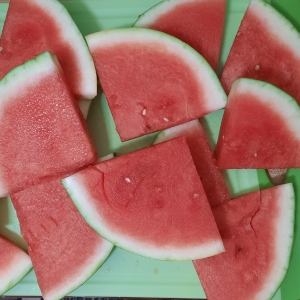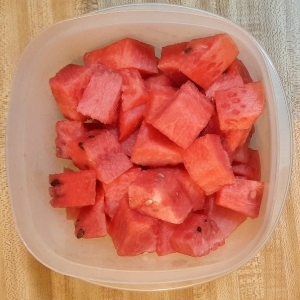These signs your watermelon may have gone bad came to me while in the grocery store to buy watermelon (my favorite fruit). Watermelon has gone through a change in the way it’s sold in grocery stores.
Watermelon can be sold whole and pre-sliced is increasingly becoming more common as the latter. We’ll be addressing both of these today. Once a watermelon has been sliced your watermelon will start to deteriorate and breakdown quicker than if it was left whole until used.
Whole Watermelon
 It goes without saying but your first inspection is and should be visual. You see a big display of watermelons and usually the first thing to attract you to the fruit. Use your own five senses to determine whether you have a good watermelon. Trust your eyes, nose, and hands.
It goes without saying but your first inspection is and should be visual. You see a big display of watermelons and usually the first thing to attract you to the fruit. Use your own five senses to determine whether you have a good watermelon. Trust your eyes, nose, and hands.
Visually, you’ll be looking for:
- Color: A ripe watermelon has a deep green color. If your melon is turning dull or yellowish, it might be overripe or bad.
- Webbing: Look for web-like patterns on the watermelon surface. The more, the better. In fact, a lack of webbing may indicate that your melon is under ripe.
- Symmetry: A symmetrical shape is a good sign. Odd shapes may suggest uneven ripening. No chunks taking out of the watermelon or dents is definitely a good sign.
- Field Spot: Look for a creamy, yellow spot where it sat on the ground. A white or green spot might mean it’s not ripe.
- Mold or decay: Whiteness or blackness may indicate mold. I usually move on to another watermelon.
Next, the feel of the watermelon should be:
- Firm: Watermelons should be consistently firm all around. You’re looking for soggy spots that may indicate that your watermelon may be moving into the over ripe category.
- No Dents: As mentioned already, dents are visual but they can also be hidden and you’ll feel them in the melon surface.
Give your watermelon a “sound” check by:
- Tapping: Give your watermelon a tap or two. A ripe one should sound hollow. If it’s dull, or has a deadened sound, the watermelon may be past its prime.
Give it a good smell, for:
- Fragrance: A fresh watermelon has a nice sweet aroma. If it’s lacking or smells off, your watermelon could be going south.
- Fermenting: I sometimes smell an alcohol smell and that’s usually a clear indicator for me to move on to another watermelon as well. This goes for whole as well as sliced watermelon
Sliced Watermelon
 As with whole watermelon, visual is a big part of what will determine if you think a watermelon is bad or not. If it looks bad, it just may be. Here’s some signs to look for.
As with whole watermelon, visual is a big part of what will determine if you think a watermelon is bad or not. If it looks bad, it just may be. Here’s some signs to look for.
- Color and Texture: The cut edges of pre-sliced watermelon should appear fresh, not dried or discolored.
- Juiciness: Press on the slices gently. They should release some juice but not be excessively wet or too dry.
- Smell:
- Packaging: Check the packaging for any signs of excess moisture, which could indicate deterioration. rips or areas that aren’t covered are also common.
- Expiration: If there’s a package date or expiration date, make sure it’s within a reasonable timeframe. Most stores will have a label saying when it was precut and packaged for sale with a corresponding expiration date.
With whole watermelon you have full control over inspection but it takes more effort to find what you’d be happy with. With pre-sliced, it’s not only convenient but time-saving. However, you are relying on the store’s freshness standards and you can likely expect your watermelon to cost more.
Storing your Watermelon
 Whole watermelon should be stored without slicing until you need it. Slicing into your watermelon immediately changes the circumstances on how to store your watermelon.
Whole watermelon should be stored without slicing until you need it. Slicing into your watermelon immediately changes the circumstances on how to store your watermelon.
Whole watermelons will last at least a week without being stored in the fridge. Putting your whole watermelon in the fridge will usually add another week for me. Waiting until you actually need or want to eat the watermelon can add days to the freshness of a sliced watermelon.
Sliced watermelon should be stored in an airtight in the fridge after returning home from the grocery or immediately after slicing yourself. Once you’ve sliced the watermelon yourself, I usually get about 5 days if it lasts that long. Watermelon that has been pre-sliced from the market should have an expiration date but you’re going to rely on visual and smell in any case.
- Leave the seeds. I will usually leave the seeds until I’m ready to eat because ripping out the seeds will break up the watermelon and shorten the storage time.
- Add lemon juice. Adding lemon juice to many types of fruit can add some much needed freshness and helps prevent the fruit from spoiling too soon.
Can you freeze your watermelon?
Yes and it was a game changer for me. It’s totally friendly in the freezer but you will have to be willing to enjoy it in a different form than the sliceable fresh watermelon you may be used to.
Here’s my process for freezing watermelon.
-
Cube or slice the watermelon into your preferred size. I will usually remove seeds (if any) and the rinds because that will save me space in the freezer.
-
Place the watermelon pieces on a baking sheet or a tray in a single layer so they don’t stick together.
-
Pre-freeze them by sticking the tray in the freezer for 2 hours (depending) until the watermelon chunks are partially frozen.
-
Once the chunks or slices have firmed up a bit, transfer these partially frozen pieces into an airtight bag or container. This is where you try and keep the air out so I will use a good freezer bag or well sealed container that traps out the air.
-
Now, just label with the date and toss them in the freezer. Frozen watermelon can last for a few months. It never goes that long in my freezer.
I hope I’ve been able to answer some common questions regarding the freshness of watermelon and what to look for. I recently got asked a few questions regarding freezing the cubed stuff because I have a garden. People tend to come to me with produce questions. I got inspired to share my thoughts on the subject here with all of you.


